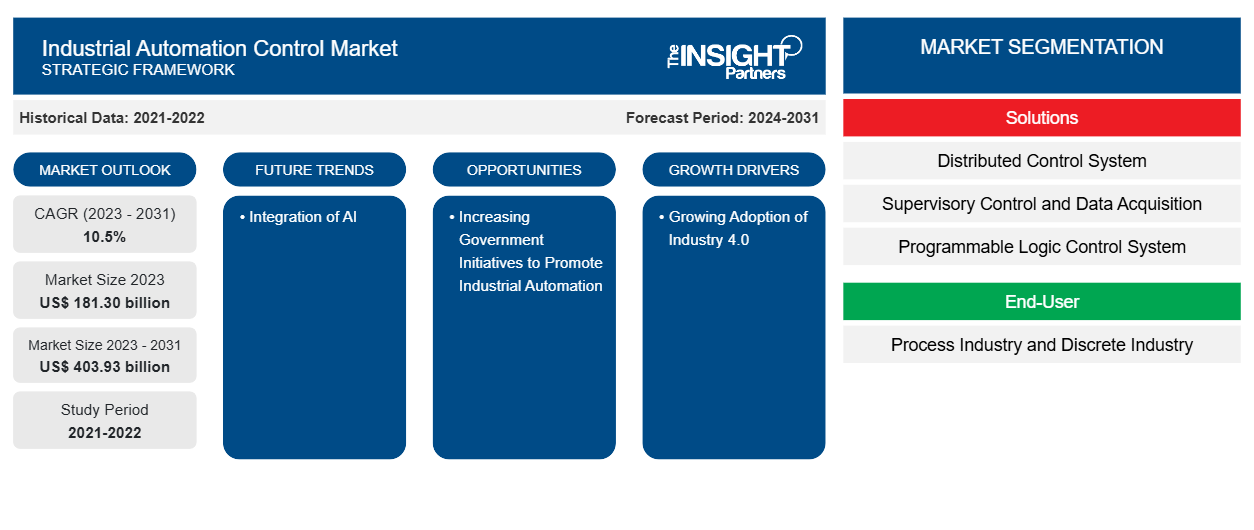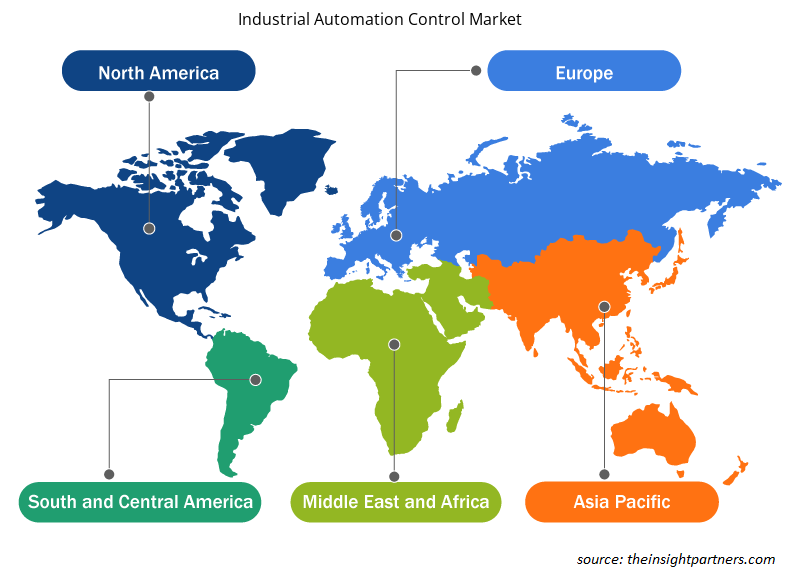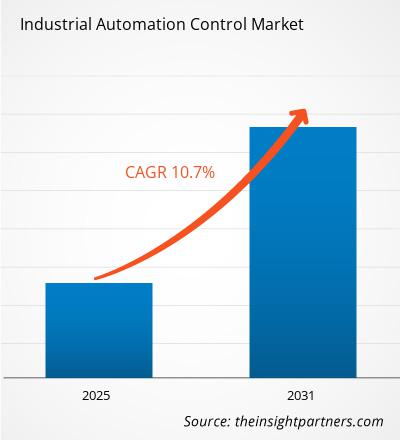من المتوقع أن يصل حجم سوق التحكم في الأتمتة الصناعية إلى 391.63 مليار دولار أمريكي بحلول عام 2031، مقارنةً بـ 193.22 مليار دولار أمريكي في عام 2024. ومن المتوقع أن يسجل السوق معدل نمو سنوي مركب قدره 10.7% خلال الفترة 2025-2031. ومن المرجح أن يُسهم دمج الذكاء الاصطناعي والتعلم الآلي في ظهور اتجاهات جديدة في السوق خلال السنوات القادمة.
تحليل سوق التحكم في الأتمتة الصناعية
تشمل الأتمتة في التصنيع مجموعة واسعة من التطبيقات، بدءًا من التحكم في خطوط التجميع وعمليات التعبئة والتغليف وصولًا إلى الإشراف على المهام المعقدة مثل التصنيع الدقيق أو الإنتاج الكيميائي. بفضل جمع البيانات وتحليلها في الوقت الفعلي، يمكن للأنظمة الآلية اكتشاف الأعطال والتنبؤ باحتياجات الصيانة وتحسين سير العمل، مما يؤدي إلى تقليل الأعطال وتوقف العمل. ويؤدي ذلك إلى بيئة إنتاج أكثر مرونة، قادرة على الاستجابة بسرعة لتغيرات السوق أو طلب المستهلكين. ومن خلال تقليل الأخطاء البشرية وتعزيز الرقابة التشغيلية، يلعب التحكم في الأتمتة الصناعية دورًا حاسمًا في تحسين سلامة مكان العمل. أما بالنسبة للشركات، فيمكن أن يؤدي ذلك إلى وفورات كبيرة في التكاليف، وتسريع دورات الإنتاج، والقدرة على توسيع نطاق العمليات بشكل أكثر فعالية. ومع استمرار الصناعات في تبني تقنيات الأتمتة، يمكنها تحقيق مستويات أعلى من التنافسية والابتكار، مما يضعها في مكانة متقدمة للنمو والنجاح على المدى الطويل في سوق رقمية وعولمية بشكل متزايد.
نظرة عامة على سوق التحكم في الأتمتة الصناعية
يشير التحكم في الأتمتة الصناعية إلى استخدام التقنيات وأنظمة التحكم المتقدمة، مثل الحواسيب والروبوتات وأنظمة المعلومات، لإدارة العمليات والآلات الصناعية ومراقبتها. يهدف التحكم في الأتمتة الصناعية إلى تحسين الكفاءة والإنتاجية والسلامة من خلال تقليل التدخل البشري في عمليات التصنيع. في قطاع الأعمال، يُبسط التحكم في الأتمتة الصناعية الإنتاج من خلال أتمتة المهام المتكررة والمستهلكة للوقت، مما يُمكّن من إنتاج مخرجات أسرع وأكثر دقة وثباتًا. من خلال الأتمتة، يُمكن للشركات تحسين الكفاءة التشغيلية، وتقليل مخاطر الأخطاء، وتقليل تكاليف العمالة، مع الحفاظ على مستويات عالية من جودة المنتج. غالبًا ما تدمج هذه الأنظمة أجهزة الاستشعار والروبوتات والذكاء الاصطناعي لمراقبة خطوط الإنتاج والتحكم فيها آنيًا، وإجراء التعديلات اللازمة لتحسين الأداء وتقليل الهدر.
قم بتخصيص هذا التقرير ليناسب متطلباتك
ستحصل على تخصيص لأي تقرير - مجانًا - بما في ذلك أجزاء من هذا التقرير، أو تحليل على مستوى الدولة، وحزمة بيانات Excel، بالإضافة إلى الاستفادة من العروض والخصومات الرائعة للشركات الناشئة والجامعات
سوق التحكم في الأتمتة الصناعية: رؤى استراتيجية

-
احصل على أهم اتجاهات السوق الرئيسية لهذا التقرير.ستتضمن هذه العينة المجانية تحليل البيانات، بدءًا من اتجاهات السوق وحتى التقديرات والتوقعات.
محركات وفرص سوق التحكم في الأتمتة الصناعية
التبني الواسع النطاق للتحكم في الأتمتة الصناعية في الصناعات المتنوعة
يتزايد انتشار التحكم الآلي الصناعي في صناعات أخرى غير صناعة السيارات. في الآونة الأخيرة، كان انتشار الصناعات غير المتعلقة بالسيارات محدودًا جدًا مقارنةً بصناعة السيارات. مع تزايد وظائف معدات مثل الروبوتات الصناعية ، من المتوقع أن تُسرّع الصناعات غير المتعلقة بالسيارات من اعتماد التحكم الآلي الصناعي.underpenetrated in comparison to the automotive industry. With the increasing functionality of equipment such as industrial
إلى جانب الصناعات، يتزايد انتشار هذه التقنية بين الدول. تتمتع الأسواق المتقدمة، بما في ذلك الصين والولايات المتحدة واليابان، بمعدل انتشار أعلى؛ ومع ذلك، لا تزال هناك فرص كبيرة متاحة للسوق الصناعي للنمو بشكل أكبر، حتى في الأسواق المتقدمة. على سبيل المثال، في عام 2023، شكلت الصين 35% من إجمالي الإنتاج، وهو ما يقرب من ثلاثة أضعاف إجمالي إنتاج الولايات المتحدة، وتأتي في المرتبة الثانية بنسبة 12%. إن احتمالات إنشاء المزيد من هذه الأنظمة ملحوظة في العديد من هذه الدول، وخاصة في الصناعات غير السيارات. ويعزى هذا النمو إلى التحديث والتحول الضروريين في هذه الأسواق. وتُعد هذه الإحصائيات واعدة للمصنعين، إذ تشير إلى المجال الهائل لمزيد من التوسع في الاعتماد.
ارتفاع الدعم الحكومي
ازدادت أهمية الحكومة وصانعي السياسات في تعزيز التحكم في الأتمتة الصناعية بشكل ملحوظ مع سعي الصناعات العالمية لتحسين الكفاءة وتبسيط عمليات التصنيع. ونظرًا للدور المحوري الذي يلعبه التحكم في الأتمتة الصناعية في قيادة الثورة الصناعية الرابعة، يتعين على الحكومات وصانعي السياسات إنشاء آليات الدعم والأطر التنظيمية المناسبة لتعزيز اعتماده ونموه على نطاق واسع. على سبيل المثال، في الهند، نفذت الحكومة عدة تدابير لتعزيز قطاع التصنيع الذكي، ومن أهمها برنامج الحوافز المرتبطة بالإنتاج (PLI). أُطلق برنامج الحوافز المرتبطة بالإنتاج (PLI) في عام 2020، ويستهدف 14 قطاعًا، بما في ذلك السيارات والأدوية والمنسوجات وتجهيز الأغذية والأجهزة المنزلية، كجزء من استراتيجية أوسع لتعزيز التصنيع المحلي. صُمم البرنامج لتشجيع الشركات على تبني ممارسات التصنيع الذكي من خلال تقديم حوافز مالية للشركات التي تنتج السلع محليًا وتفي بمعايير محددة للاستثمار والمبيعات والتصدير. تهدف هذه المبادرة إلى تعزيز القدرة التنافسية لهذه الشركات، وبالتالي رفع القيمة الإجمالية لقطاع التصنيع في الهند.PLI) scheme. Launched in 2020, the PLI scheme targets 14 sectors, including automobiles, pharmaceuticals, textiles, food processing, and white goods, as part of a broader strategy to promote domestic manufacturing. The scheme is designed to encourage companies to adopt smart manufacturing practices by offering financial incentives to those that produce goods locally and meet specific investment, sales, and export criteria. This initiative aims to enhance the competitiveness of these companies and, in turn, elevate the overall value of India's manufacturing sector.
وبالمثل، في الولايات المتحدة، أعلنت وزارة الطاقة في عام 2023 عن مبادرة بقيمة 22 مليون دولار أمريكي لدعم 12 برنامجًا حكوميًا لتسريع اعتماد التصنيع الذكي في المنشآت الصغيرة والمتوسطة. تهدف هذه المبادرة، الممولة بموجب قانون البنية التحتية الرئاسي المشترك بين الحزبين، إلى تعزيز الوصول إلى تقنيات التصنيع الذكي والحوسبة عالية الأداء في قطاع التصنيع الأمريكي. علاوة على ذلك، في أغسطس 2023، اختار معهد الروبوتات المتقدمة للتصنيع (ARM) ثمانية مشاريع تكنولوجية جديدة قصيرة الأجل ضمن القائمة المختصرة، ويعتزم منح مساهمة إجمالية تبلغ حوالي 3.26 مليون دولار أمريكي للتمويل من خلال دعوة مشاريع التكنولوجيا 23-01. من المتوقع أن توفر هذه المبادرات فرصة مهمة لتعزيز قطاع التصنيع الذكي ، مما يعزز نمو سوق التحكم في الأتمتة الصناعية .
تقرير تحليل تجزئة سوق التحكم في الأتمتة الصناعية
القطاعات الرئيسية التي ساهمت في اشتقاق تحليل سوق التحكم في الأتمتة الصناعية هي النظام والمستخدم النهائي.
- بناءً على النظام، يُقسّم سوق التحكم في الأتمتة الصناعية إلى أنظمة SCADA، وDCS، وPLC، وPLM، وغيرها. وقد هيمن قطاع SCADA على السوق في عام 2024.
- بناءً على المستخدم النهائي، ينقسم سوق التحكم في الأتمتة الصناعية إلى قطاعي العمليات والقطاعات المنفصلة. وسيُهيمن قطاع الصناعات المنفصلة على السوق في عام ٢٠٢٤.
تحليل حصة سوق التحكم في الأتمتة الصناعية حسب المنطقة الجغرافية
يُقسّم سوق التحكم في الأتمتة الصناعية إلى خمس مناطق رئيسية: أمريكا الشمالية، وأوروبا، وآسيا والمحيط الهادئ، والشرق الأوسط وأفريقيا، وأمريكا الجنوبية. وقد هيمنت أمريكا الشمالية على السوق في عام 2024.
في جميع أنحاء أمريكا الشمالية، عززت التطورات التكنولوجية أسواقًا شديدة التنافسية، مما جعل المنطقة مركزًا للابتكار والقوة الاقتصادية. وتعمل شركات المنطقة باستمرار على تحسين عملياتها التجارية لتلبية الطلب المتزايد على المنتجات والخدمات عالية الجودة بأعلى كفاءة.
تُنفّذ شركات عالمية مبادرات متنوعة لتعزيز نمو سوق التحكم في الأتمتة الصناعية. على سبيل المثال، في ديسمبر 2024، أعلنت شركة ONDEX Automation ("ONDEX" أو "الشركة") عن إبرامها شراكة مع شركة Automation & Control Inc. ("ACI")، وهي شركة رائدة في أنظمة التحكم وخدمات الأتمتة الصناعية، ومقرها مورستاون، نيوجيرسي. تُمثّل هذه الشراكة الاستراتيجية إنجازًا هامًا في مسيرة ONDEX Automation لتقديم حلول أتمتة مبتكرة لعملائها من قطاع التصنيع في أمريكا الشمالية. بدعم من شركة Shore Capital Partners، وهي شركة استثمار خاص مقرها شيكاغو، تعمل ONDEX Automation على بناء شركة رائدة في مجال تكامل الأنظمة لتلبية احتياجات عملائها من قطاع التصنيع في أمريكا الشمالية. تسعى ONDEX جاهدةً إلى اغتنام فرص إضافية للشراكة مع شركات تكامل أنظمة أتمتة المصانع التي تتمتع بقدرات متنوعة، وكفاءات هندسية ذات خبرة، والتزام مشترك بالابتكار والتميز. من بين الشركات الرئيسية في سوق التحكم في الأتمتة الصناعية في أمريكا الشمالية شركة Rockwell Automation Inc.، وشركة ABB Ltd.، وشركة Mitsubishi Electric Corporation. تُساهم هذه الشركات في دفع عجلة الابتكار ورسم ملامح مستقبل الأتمتة الصناعية في المنطقة.
رؤى إقليمية حول سوق التحكم في الأتمتة الصناعية
قام محللو إنسايت بارتنرز بشرح شامل للاتجاهات والعوامل الإقليمية المؤثرة في سوق التحكم في الأتمتة الصناعية خلال فترة التوقعات. ويناقش هذا القسم أيضًا قطاعات سوق التحكم في الأتمتة الصناعية ونطاقه الجغرافي في أمريكا الشمالية، وأوروبا، وآسيا والمحيط الهادئ، والشرق الأوسط وأفريقيا، وأمريكا الجنوبية والوسطى.

- احصل على البيانات الإقليمية المحددة لسوق التحكم في الأتمتة الصناعية
نطاق تقرير سوق التحكم في الأتمتة الصناعية
| سمة التقرير | تفاصيل |
|---|---|
| حجم السوق في عام 2024 | 193.22 مليار دولار أمريكي |
| حجم السوق بحلول عام 2031 | 391.63 مليار دولار أمريكي |
| معدل النمو السنوي المركب العالمي (2025 - 2031) | 10.7% |
| البيانات التاريخية | 2021-2023 |
| فترة التنبؤ | 2025-2031 |
| القطاعات المغطاة |
حسب النظام
|
| المناطق والدول المغطاة |
أمريكا الشمالية
|
| قادة السوق وملفات تعريف الشركات الرئيسية |
|
كثافة اللاعبين في سوق التحكم في الأتمتة الصناعية: فهم تأثيرها على ديناميكيات الأعمال
يشهد سوق التحكم الآلي الصناعي نموًا سريعًا، مدفوعًا بتزايد طلب المستخدم النهائي نتيجةً لعوامل مثل تطور تفضيلات المستهلكين، والتقدم التكنولوجي، وزيادة الوعي بمزايا المنتج. ومع تزايد الطلب، تعمل الشركات على توسيع عروضها، والابتكار لتلبية احتياجات المستهلكين، والاستفادة من الاتجاهات الناشئة، مما يعزز نمو السوق.
تشير كثافة اللاعبين في السوق إلى توزيع الشركات العاملة في سوق أو قطاع معين. وتشير إلى عدد المنافسين (اللاعبين في السوق) الموجودين في سوق معين نسبةً إلى حجمه أو قيمته السوقية الإجمالية.
الشركات الرئيسية العاملة في سوق التحكم في الأتمتة الصناعية هي:
- شركة أيه بي بي المحدودة
- شركة هانيويل الدولية
- شركة سيمنز ايه جي
- شركة إيمرسون الكهربائية
- شركة بوش ريكسروث إيه جي
- شركة جنرال إلكتريك
إخلاء المسؤولية : الشركات المذكورة أعلاه ليست مرتبة بأي ترتيب معين.

- احصل على نظرة عامة على أهم اللاعبين الرئيسيين في سوق التحكم في الأتمتة الصناعية
أخبار سوق التحكم في الأتمتة الصناعية والتطورات الأخيرة
يُقيّم سوق التحكم في الأتمتة الصناعية بجمع بيانات نوعية وكمية بعد البحث الأولي والثانوي، والتي تشمل منشورات الشركات المهمة، وبيانات الجمعيات، وقواعد البيانات. فيما يلي بعض التطورات في سوق التحكم في الأتمتة الصناعية:
- تعمل شركة Bosch Rexroth على توسيع نظام BODAS الخاص بها في مجال الأتمتة من خلال حلين جديدين: يتيح نظام تجنب الاصطدام منع الاصطدام بشكل فعال من خلال الكشف الدقيق عن الأشياء والكشف عن الأشخاص باستخدام الرادار والموجات فوق الصوتية والكاميرات الذكية.
(المصدر: بوش ريكسروث، بيان صحفي، 2025)
- أطلقت شركة ABB سلسلة ABB Ability Symphony Plus SDe، وهي مجموعة من منتجات الأجهزة التي تُساعد على تحديث أنظمة التحكم في العمليات الحالية مع الحد الأدنى من المخاطر والانقطاعات في عمليات المصانع. تُمكّن هذه السلسلة الجديدة مُشغّلي المصانع في قطاعات مثل الطاقة والمياه والنفط والغاز والأدوية واللب والورق من تحديث أنظمة التحكم المُستخدمة لتتوافق مع أحدث التقنيات، مما يُعزز الكفاءة والإنتاجية.
(المصدر: ABB، بيان صحفي، 2024)
تغطية تقرير سوق التحكم في الأتمتة الصناعية والنتائج المتوقعة
يوفر "حجم سوق التحكم في الأتمتة الصناعية وتوقعاته (2021-2031)" تحليلًا مفصلاً للسوق يغطي المجالات المذكورة أدناه:
- حجم سوق التحكم في الأتمتة الصناعية وتوقعاته على المستويات العالمية والإقليمية والوطنية لجميع قطاعات السوق الرئيسية التي يغطيها النطاق
- اتجاهات سوق التحكم في الأتمتة الصناعية بالإضافة إلى ديناميكيات السوق مثل المحركات والقيود والفرص الرئيسية
- تحليل مفصل لـ PEST و SWOT
- تحليل سوق التحكم في الأتمتة الصناعية يغطي اتجاهات السوق الرئيسية والإطار العالمي والإقليمي والجهات الفاعلة الرئيسية واللوائح والتطورات الأخيرة في السوق
- تحليل المشهد الصناعي والمنافسة الذي يغطي تركيز السوق، وتحليل خريطة الحرارة، واللاعبين البارزين، والتطورات الأخيرة لسوق التحكم في الأتمتة الصناعية
- ملفات تعريف الشركة التفصيلية
- التحليل التاريخي (سنتان)، سنة الأساس، التوقعات (7 سنوات) مع معدل النمو السنوي المركب
- تحليل PEST و SWOT
- حجم السوق والقيمة / الحجم - عالمي، إقليمي، بلد
- الصناعة والمنافسة
- مجموعة بيانات إكسل
التقارير الحديثة
شهادات العملاء
سبب الشراء
- اتخاذ قرارات مدروسة
- فهم ديناميكيات السوق
- تحليل المنافسة
- رؤى العملاء
- توقعات السوق
- تخفيف المخاطر
- التخطيط الاستراتيجي
- مبررات الاستثمار
- تحديد الأسواق الناشئة
- تحسين استراتيجيات التسويق
- تعزيز الكفاءة التشغيلية
- مواكبة التوجهات التنظيمية






















 احصل على عينة مجانية ل - سوق التحكم في الأتمتة الصناعية
احصل على عينة مجانية ل - سوق التحكم في الأتمتة الصناعية